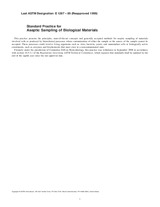Potrebujeme váš súhlas na využitie jednotlivých dát, aby sa vám okrem iného mohli ukazovať informácie týkajúce sa vašich záujmov. Súhlas udelíte kliknutím na tlačidlo „OK“.
ASTM E1287-89(1999)
Standard Practice for Aseptic Sampling of Biological Materials (Withdrawn 2008)
Automaticky preložený názov:
Štandardná prax pre aseptické odberu biologického materiálu ( Withdrawn 2008 )
NORMA vydaná dňa 10.10.1999
Informácie o norme:
Označenie normy: ASTM E1287-89(1999)
Poznámka: NEPLATNÁ
Dátum vydania normy: 10.10.1999
Kód tovaru: NS-41140
Počet strán: 5
Približná hmotnosť: 15 g (0.03 libier)
Krajina: Americká technická norma
Kategória: Technické normy ASTM
Anotácia textu normy ASTM E1287-89(1999) :
Keywords:
Bacteria/bacterial control, Biological data analysis, Biotechnology, Contamination-environmental, Dead leg zone, Drug applications, Enzymes, Noncontaminated biological materials, Parental drug applications, Sampling-biological materials, Sterilization, Virology, Yeasts, aseptic sampling of biological materials, practice, ICS Number Code 07.080 (Biology. Botany. Zoology)
Doplňujúce informácie
| Significance and Use |
|
This practice should be used for removing samples from biological processes in the laboratory or commercial manufacturing facilities where the sample system removes the sample from the process for use in external testing. This practice also addresses the sampling procedures required for in-situ measurements wherein the sample is not removed from the process but must represent the process material being tested. Generally, the in-situ measurement device is either sterilized separately from the process equipment and then inserted into the sterilized equipment, or the in-situ device is permanently mounted in the equipment and then sterilized together with the equipment. Levels of contamination are not specified in this practice since each biological system and bioprocess can differ as to the amount and types of micro-organism, bacteria, virus, and other contaminants that can be allowed in the sample and process materials for acceptable operations under CGMP or similar requirements. With the properly designed micro-organism challenges to the sterile system, then the sample system can be tested and validated. Since biological process samples can vary widely in sterility requirements, sample size, material composition, (liquid, vapor, slurry, etc.), stability, and other characteristics, the practices described herein are general and are to be applied as appropriate to each specific situation. These practices are limited to aseptic sampling conditions and are not intended to apply to containment of highly toxic or hazardous materials that require additional precautions to avoid exposure of the sample contents to the environment, or workers, where health and other safety considerations could require more stringent practices. Sample applications can include the following: 5.4.1 External Testing of Removed Samples: Liquid chromatography, spectroscopy (ultraviolet, infrared, and fluorescence), fiber optics, mass spectroscopy, 5.4.2 Direct Measurement of In-Situ Sample: Temperature, pressure, pH, etc. |
| 1. Scope |
|
1.1 This practice presents the principles, state-of-the-art concepts and generally accepted methods for aseptic sampling of materials involved with or produced by biotechnical processes where contamination of either the sample or the source of the sample cannot be accepted. These processes could involve living organisms such as virus, bacteria, yeasts, and mammalian cells or biologically active constituents, such as enzymes and biochemicals that must exist in a noncontaminated state. 1.2 This practice also applies to the products from these bioprocesses that can be for human consumption, sterile or parental drug applications, which also require aseptic sampling to meet regulatory, current good manufacturing practices, or other quality control requirements. 1.3 Warning-Since some biotechnical processes could produce flammable products, this sampling practice should be applied only after taking into account all of the factors that are pertinent to an assessment of the fire hazard of a particular end use. 1.4 This standard may involve hazardous materials, operations, and equipment. This standard does not purport to address all of the safety problems associated with its use. It is the responsibility of the user of this standard to establish appropriate safety and health practices and determine the applicability of regulatory limitations prior to use. |
Odporúčame:
EviZak - všetky zákony vrátane ich evidencie na jednom mieste
Poskytovanie aktuálnych informácií o legislatívnych predpisoch vyhlásených v Zbierke zákonov od roku 1945.
Aktualizácia 2x v mesiaci !
Chcete vedieť viac informácii ? Pozrite sa na túto stránku.




 Cookies
Cookies
